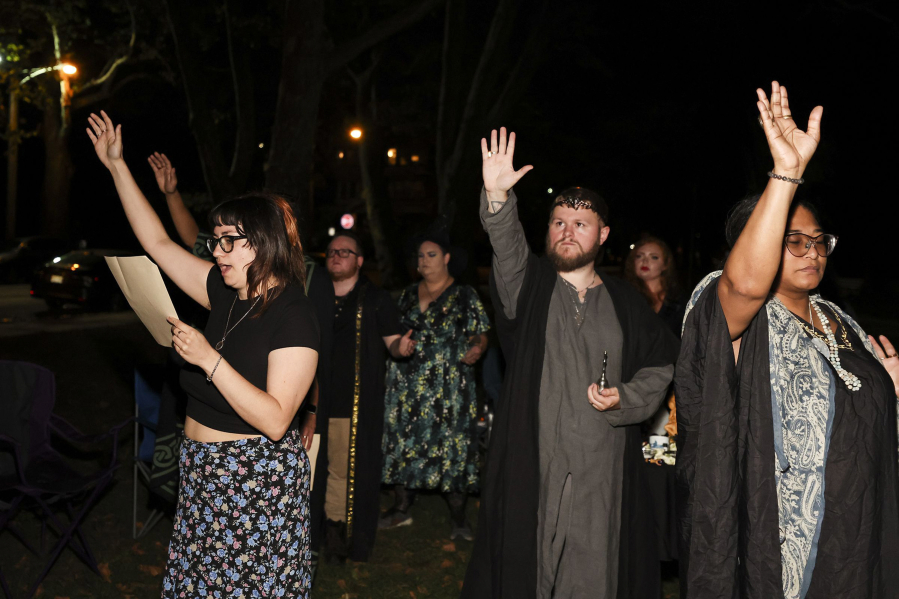PHILADELPHIA — The witches circled an altar in the shadow of Clark Park’s sycamores last month, orange street light illuminating their black hats and robes.
“By the anointing with this sacred oil, may your spirit come into attunement with the energies of the moon,” said Jim “Raven” Stefanowicz, high priest of the South Street Circle, a pagan ritual group, as he daubed a blend of jasmine, orris, and vanilla onto the wrists of those gathered. Nearby, an ice cream truck tinkled and a trolley rumbled past; live action role players whacked each other with foam weapons a few yards away.
No matter — these were city witches. The full moon, even hidden by clouds and light pollution, still exerts its pull.
At a moment when you can buy a box of sage smudge sticks at Walmart, when everyone has something to say about Mercury being in retrograde and Virgo season and natal charts, the actual magical community of Philadelphia is perhaps more vibrant than ever. The South Street Circle even puts out a quarterly newsletter.
Witches in the city gather in covens and more informal circles to cast spells, bless cake and ale, and celebrate the seasons through ancient pagan rites. An annual Pagan Pride festival each September draws around 600 people, Stefanowicz said.
Under the “pagan” umbrella, practitioners observe a wide range of faiths rooted mostly in the religions of pre-Christian Europe, from Wicca, a religion of witchcraft, to Heathenry to Hellenic Polytheism. There are about 10 practicing covens in the area and the number of Wiccans is growing, said Benny Bargas, who is currently teaching an introduction to Wicca class in South Philly. (His coven meets privately and does not allow casual observers.)
Lexa Lizzi, 49, calls herself a hereditary practitioner because her grandmother and great-great-grandmother were witches. She used to think she was one of the only witches in West Philadelphia.
She did spiritual work to attract and notice other witches, she said, and about 15 years ago, she began attending Pagan Pride. She realized she was wrong about her solitary existence.
“Boom, witches everywhere,” Lizzi said.
At the full moon rite, after sharing gratitude and blessing a goblet of mead, the witches turned counterclockwise from north to east to close the circle.
“Hail and farewell,” they intoned in each direction. Afterward, they chatted in camp chairs and sipped mead from tiny paper cups. Someone placed an iPhone in the altar’s cast iron cauldron, creating an impromptu speaker, and a few people danced around it.
The high priest of the South Street Circle, like a number of its members, was raised Catholic. Stefanowicz was a soloist in his church choir for two decades and to this day, some family members maintain “a quiet fearfulness” for his soul, he said. But he didn’t like the rigidity of Catholic doctrine or the emphasis on faith solely to avoid damnation.
When he began exploring paganism in the early aughts, through books and AOL chat rooms, he was moved by the welcoming acceptance of the faith. Even the concept of hell in Norse tradition is far different than in Roman Catholicism: It’s not a place for damned souls to suffer for all eternity, but instead one for common people who didn’t die in battle to live out their days, Stefanowicz said.
The faiths continue to intermingle: Stefanowicz now works as a professional tarot reader and holds sessions for a local Roman Catholic priest.
In the Middle Ages, accused witches were sometimes single women who understood plants and helped women deliver babies and prevent pregnancies. Rue and Jay Gregory, who are both trans, identified with the witch as a powerful symbol of the “other.”
They’ve belonged to the South Street Circle for about five years. When they recently hosted their handfasting ceremony, a pagan wedding rite, circle members served as their chosen family.
“The witch throughout history was always the one who was the healer — but also the cursor, but also the hex breaker,” Jay Gregory, 32, said.




